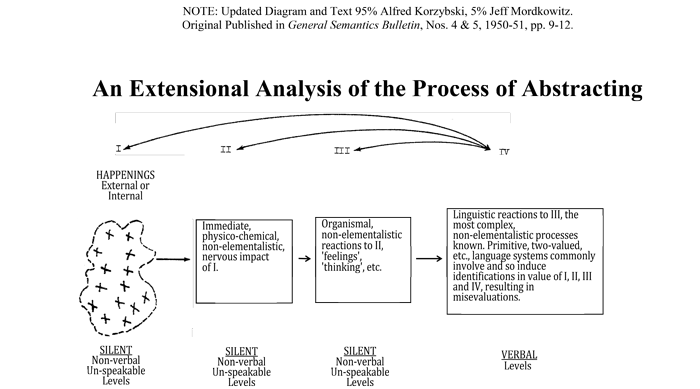

An Extensional Analysis of the Process of Abstracting From a Non-Elementalistic, Non-Aristotelian Point of View
by Alfred Korzybski
(with some updates by Jeff Mordkowitz)
Originally Published in General Semantics Bulletin, Nos. 4 & 5, 1950-51, pp. 9-12
Our knowledge today indicates that all life is non-elementalistic in character, the functioning of the nervous system included. We do not as yet know the intrinsic mechanisms, but from an non-elementalistic point of view every part of the brain is connected with every other part, and with our nervous system as a whole. With such a foundation, even though it becomes necessary to investigate different aspects of the processes of abstracting for purposes of analyses, we should be aware that these different aspects are parts of one whole continuous process of normal human life.
Let us consider what our nervous system does when we 'perceive' a happening or event. I use the term 'event' in the sense of Whitehead as an instantaneous cross section of a process. Say we drop a box of matches . Here we have a first-order happening, which occurs on non-verbal or what is called the 'silent' or 'un-speakable' levels. The reflected light impinges on the eye, we get some sort of non-elementalistic configurations in our brain; then, since we are sentient organisms, we can react to those configurations with some sort of 'feelings', some evaluations, etc., about them, on silent levels. Finally, on the verbal levels, we can speak about those organismal reactions. Newton may have said about the falling match box, 'gravitation'; Einstein may say, 'space-time curvature'. Whatever we may say about it, the first-order happening remains on the silent levels. How we will talk about it may differ from day to day, or from year to year, or century to century. All our 'feelings', 'thinkings'; our 'loves', 'hates', etc., happen on silent un-speakable levels, but may be affected by the verbal levels by a continuing interplay. We may verbalize about them, to ourselves or others, intensify, decrease them, etc., but this is a different problem.
In the following diagram is given an extensional analysis of the process of abstracting from a non-elementalistic non-Aristotelian point of view. It is oversimplified and could be made more exhaustive. However, it is satisfactory for our purpose of explaining briefly the most general and important points.

Most of us identify in value levels I, II, III, and IV, and react as if our verbalizations about the first three levels were 'it'. Whatever we may say something 'is', obviously is not the 'something' on the silent levels. Indeed, as Wittgenstein wrote, 'What can be shown, cannot be said'. In my experience I found that it is practically impossible to convey the differentiation of silent (unspeakable) levels from the verbal without having the hearer or reader pinch with one hand a finger of the other hand. They would then realize organismically that the first-order psycho-logical direct experiences are not verbal. The simplicity of this statement is misleading, unless we become aware of its implications, as in our living reactions most of us identify in value the entirely different levels, with often disastrous consequences.
Unfortunately, people in general, including many scientists, disregard levels II and III completely, and react as if unconscious that IV 'is not' I. In other words, we do not take into account the mechanisms of the human nervous system or 'think non-elementalistically' about our reactions. Such a disregard leads to misunderstandings, heated two-valued ('either-or') debates, hostilities, prejudices, bitterness, etc. In the history of 'philosophy', for example, the metaphysical fight about 'solipsism' simply ceases to be a problem when we become conscious that the only possible link between the inherently different silent (non-verbal) and verbal levels is found in their similarity of structure, expressed in terms of relations, on which the present non-Aristotelian system is based.
An awareness of the processes of abstracting clarifies the structure of a great many of our inter-personal, professional, etc., difficulties, which may become trivial or non-existent if we become conscious of the identifications involved. Self-made problems often turn out to be no problems.
Statements are verbal; they are never the silent 'it'. One may have a nightmare that he 'is' a Stalin. That may be innocent enough. One may have day-dreams of being a Stalin. That is more serious. One may proclaim consciously, 'I am Stalin', and believe in it, and begin to shoot people who disagree with them; usually such a person is locked up in a hospital, and is usually a hopeless case.
We see how the above diagram indicates human evaluational mechanisms in the average individual who is hovering between sanity and evaluational illness. It is well known that what would be only a dream to a 'normal' person, 'is reality' to a person suffering from forms of schizophrenia, who lives and acts accordingly.
These mechanisms also function pathologically in infantile adults, who live in a fictitious world built up on identifications.
The verbal levels, in the meantime, are of unique human importance because we can abstract on higher and higher verbal levels from I, II, III, etc. In human life IV represents a means for inter-communicating and transmitting from individual to individual and generation to generation the accumulated experiences of individuals and humanity at large. I call this human capacity the 'time-binding' characteristic.
The symbolic levels of behavior differentiate most sharply human reactions from signal reactions of lower, less complex forms of life. If those accumulated experiences are not properly verbalized, it may seriously twist or even arrest human development.
This simple diagram represents most complex processes, involving 'perception' on different levels, problems of interpretation, verbal formalism, etc. Every type of human reactions from the lowest to the highest levels involves these mechanisms, the non-awareness of which may lead to disturbing, frustrating, or disastrous misevaluations and consequences.
I have stressed the serious or tragic aspect of our processes of abstracting here because I am attempting to convey the heavy life-value of what may otherwise appear too simple and obvious.